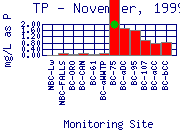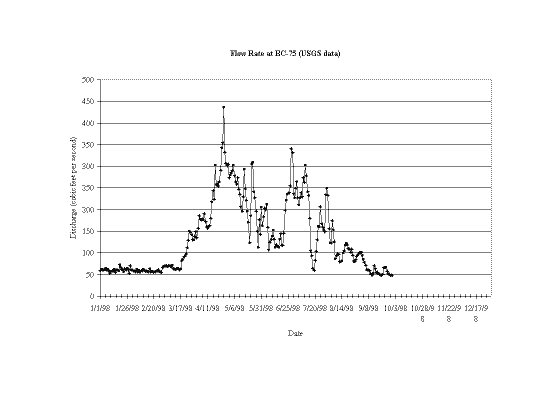 |
|
 |
|
 Phosphorus concentrations are usually low or undetectable in the upper part of Boulder Creek.
Total phosphorus and orthophosphorus concentrations increase significantly at sampling site BC-75, due to outfall from the Boulder Wastewater Treatment Plant (WWTP).
The City of Boulder meets discharge requirements of the Colorado Department of Public Health and Environment, but some phosphorus remains in the effluent.
Concentrations downstream from the WWTP generally decrease due to dilution (as in November 1999).
Phosphorus concentrations are usually low or undetectable in the upper part of Boulder Creek.
Total phosphorus and orthophosphorus concentrations increase significantly at sampling site BC-75, due to outfall from the Boulder Wastewater Treatment Plant (WWTP).
The City of Boulder meets discharge requirements of the Colorado Department of Public Health and Environment, but some phosphorus remains in the effluent.
Concentrations downstream from the WWTP generally decrease due to dilution (as in November 1999).

The flow rate of Boulder Creek largely influences phosphorus concentrations in Boulder Creek. From April to September, flow in Boulder Creek is higher due to snowmelt runoff and thunderstorms (see 1998 discharge rate at BC-75).

The high volume of water dilutes phosphorus concentrations in the creek.
During low-flow months, wastewater effluent discharged from the WWTP dominates stream flow in lower Boulder Creek, often comprising over half of the total flow.

Orthophorus (as P) values are generally very similar to total phosphorus (as P) values, indicating that the phosphorus is mostly in the form of orthophosphorous.
Phosphorus Standards
No national or state criteria have been established for concentrations of phosphorus compounds in water; however, to control eutrophication, the U.S. Environmental Protection Agency (EPA) makes the following recommendations: total phosphate should not exceed 0.05 mg/L (as phosphorus) in a stream at a point where it enters a lake or reservoir, and should not exceed 0.1 mg/L in streams that do not discharge directly into lakes or reservoirs (Muller and Helsel, 1999). Concentrations at upper Boulder Creek sampling sites were usually below 0.1 mg/L in 1998 and 1999, but this level was exceeded at several locations a few months of each year. Total phosphorus concentrations in lower Boulder Creek were significantly higher, with concentrations up to 5 mg/L (as P).